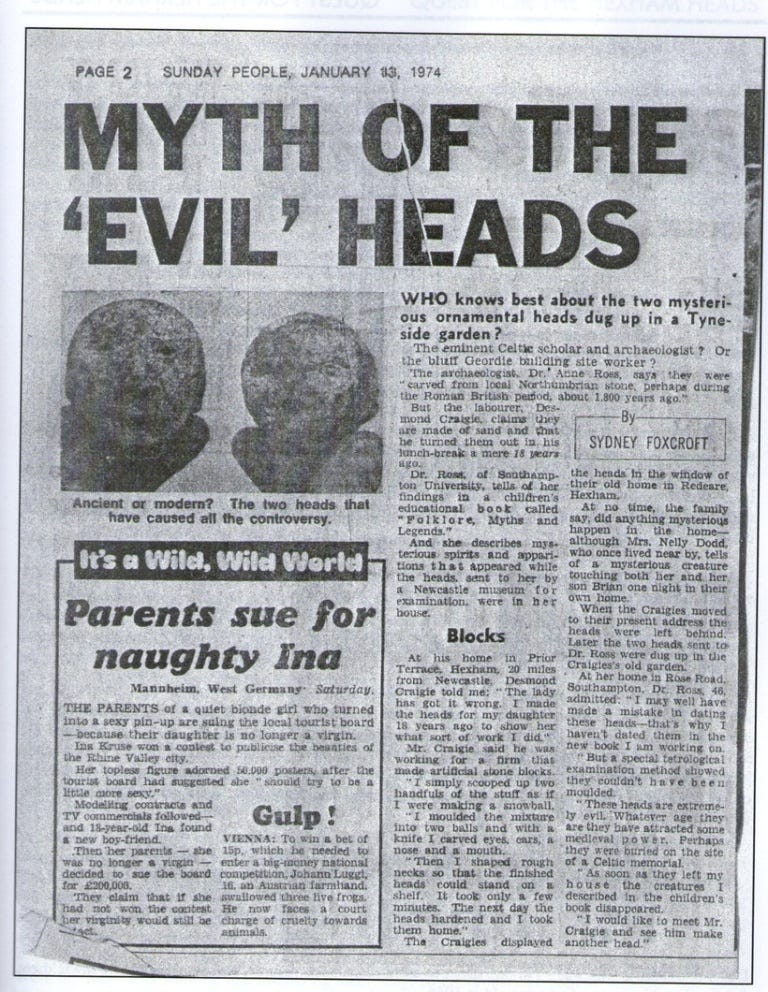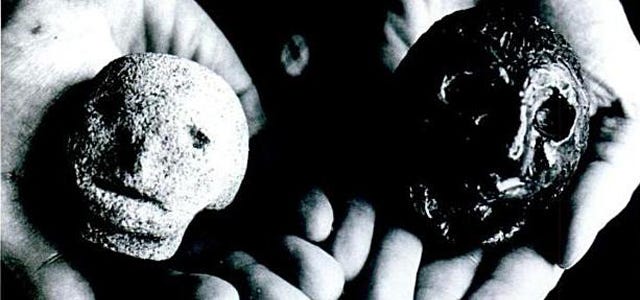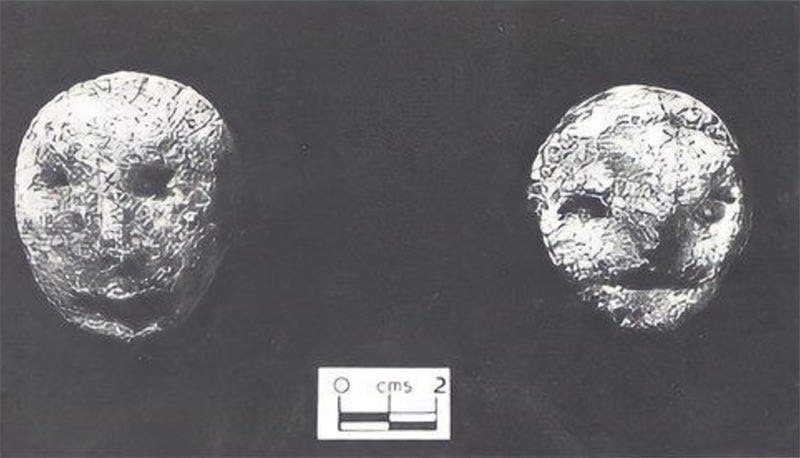The Hexham Heads
Two small carved faces into stone unearthed in a Northumberland garden, awaken something ancient and inhuman.
Case File: The Hexham Heads Case No.: 44-EN-1971-NC
Classification: Cursed Artefacts – Poltergeist and Shape-Shifting Entity
Location: Hexham, Northumberland, England
Date of Incident: 1971 – 1974
Filed by: Don and Carol Robson
Status: Closed – Artefacts Removed, Activity Ceased
Supporting Paranormal Casefiles by buying a coffee or a book truly means the world to me, every contribution goes straight back into the project, helping me afford research materials, archive access, and the tools I need to keep exploring and sharing these strange and unsettling stories. I'm incredibly grateful for your support
Incident Summary
In early 1971, in the quiet Northumberland town of Hexham, two young boys unearthed a pair of small carved heads while digging in the garden of their home at 3 Rede Avenue. Colin and Leslie Robson, aged 11 and 15, had no idea their discovery would become the centre of one of the UK's most peculiar paranormal cases. The heads were about the size of apples, made of a heavy stone or concrete-like material, and roughly carved with distinct facial features. One appeared to represent a male face, the other a female.
The Robson family initially treated the find with curiosity. The heads were passed around to neighbours and examined by teachers at the local school. But within days, the family began reporting disturbances in their home. These included sudden cold spots, unexplained noises, the movement of objects, and an increasing sense of unease. These incidents escalated to such a degree that the family began to suspect the heads were not merely historical curiosities, but cursed objects.
The disturbances did not cease when the heads were moved to the home of a neighbour, Mrs Dodds. If anything, they worsened. At this point, the story caught the attention of researchers and made its way into the British press.
Phenomena Overview
Physical Disturbances:
Chairs and tables were reported to shift without human contact. Light bulbs blew frequently. Electrical appliances malfunctioned. Doors slammed spontaneously. Cold drafts appeared in rooms with no open windows or doors. The heads themselves were said to shift position slightly when no one was watching, sometimes turning to face different directions.
Auditory Phenomena:
Witnesses reported footsteps on stairs and landings when no one else was present. Breathing sounds and whispering voices were heard in empty rooms. Knocking and scratching noises came from the walls.
Visual Phenomena and Apparitions:
Mrs Dodds' teenage daughter witnessed a terrifying humanoid figure described as part animal and part man. The creature was tall, hairy, and had glowing yellow eyes. It appeared in her room and vanished through a solid wall. A similar entity was later reported by archaeologist Dr Anne Ross, who took the heads into her home for academic analysis.
Animal Reactions:
Domestic pets, particularly dogs, became distressed or aggressive when near the heads. Some refused to enter the rooms where the objects were kept. Others growled or barked at unseen presences.
Psychological Effects:
Multiple individuals exposed to the heads experienced heightened anxiety, disturbed sleep, and the sensation of being watched. Some described sudden mood shifts while in the presence of the artefacts.
Investigation Overview
Academic Interest and Professional Involvement:
The heads were handed to Dr Anne Ross, a respected Celtic studies scholar, who initially believed them to be of ancient origin. She considered the possibility that they were linked to pre-Roman Celtic religious practices or household deity figures known as "Lares". However, her opinion shifted when she and her family began to experience unexplained activity. Dr Ross reported seeing a creature matching the Dodds’ description, and became convinced that the artefacts were connected to supernatural phenomena rather than archaeology.
Comparative Folklore and Mythological Context:
The entity seen in conjunction with the heads was compared to various figures in British and Celtic folklore, including the Barguest, a spectral black dog, and the wulver, a benevolent werewolf-like figure from Shetland tradition. The recurring themes of shape-shifting, protection, and curse were considered relevant.
Material Analysis:
The heads were analysed and found to be made from a type of concrete or stone mixed with quartz, but no definitive age could be determined. Their style did not match known ancient artefacts, yet their presence triggered real and measurable emotional and physical responses in multiple individuals.
Controversy Over Origins:
Later, a man named Des Craigie came forward claiming he had made the heads while living at the same house years earlier. According to Craigie, they were fashioned from moulded cement as part of a personal project and buried as a prank or decorative feature. This revelation cast doubt on their supposed antiquity, but did not explain the reported disturbances or why they seemed to follow the objects across multiple households.
Press Coverage and Public Reaction
The Hexham Heads case drew significant media interest throughout the 1970s. Local and national papers reported on the bizarre series of events, and the case was widely discussed in paranormal and academic circles alike. For a time, the story was featured in occult and supernatural journals and became a staple of British haunted object lore.
Public opinion was split. Some believed the heads were genuine relics of an ancient pagan culture. Others accepted the idea that they were modern creations that had, through some unknown means, become imbued with negative energy. The creature sightings were especially troubling, and many readers found the consistency of witness reports difficult to dismiss.
Interest in the case has endured, with modern investigators and television programmes revisiting the story. The heads themselves have vanished from public view. Their last confirmed location was a university archive, but no current institution claims to have them.
Case Status
Following the removal of the heads from the Robson, Dodds, and Ross households, all reported paranormal activity ceased. No further incidents linked to the artefacts have been verified since the mid-1970s. The case is considered closed from an investigative standpoint, though its cause remains unexplained.
To this day, the Hexham Heads remain one of the most peculiar cases in British paranormal history. Whether they were ancient relics, modern objects with accidental power, or psychological triggers is still debated. The physical and emotional impact they had on those who encountered them, however, is a matter of record.
The Story
It began in spring, just before dusk, when two boys turned over soil in their back garden and struck something hard. They expected a rock or old rubbish. Instead, they pulled out a pair of grey stone heads. Cold and roughly carved, each bore a crude face. One had a rounded forehead and a crooked nose. The other, slightly smaller, had almond-shaped eyes and a flattened base. They looked ancient, but the family had no reason to suspect anything more than coincidence.
The heads were shown to neighbours, passed around, admired for their oddity. Colin and Leslie brought them into the house. They sat on a shelf in the lounge. Then the disturbances started. First came the cold spots. Then the sounds. Late at night, footsteps would echo across the upstairs landing. Doors creaked open and closed without wind or movement. Objects vanished. Carol Robson felt watched in her own kitchen. Her sleep became broken. She began to wake in panic, convinced someone was standing at the foot of her bed.
One evening, the entire family returned from a walk to find every cupboard door in the kitchen standing wide open. A few nights later, the television switched on by itself, the volume rising steadily until it shrieked white noise into the dark.
Frightened, they passed the heads to their neighbour, Mrs Dodds, hoping to rid themselves of whatever had followed the artefacts. But the activity not only persisted, it escalated. One night, Mrs Dodds' teenage daughter let out a scream that woke the entire street. She said she had seen a tall figure by the bedroom door. It was not a man, not entirely. Hair covered its arms and chest. Its eyes were luminous. It stared at her for what felt like minutes, then turned and vanished through the wall.
This was the turning point. The case reached the local press and attracted the attention of Dr Anne Ross. A scholar of early Celtic religions, Ross took the heads into her own home, considering them valuable relics. Within days, her household began to suffer. Her daughter experienced night terrors. A shadow passed through the hallway when no one was there. Ross herself witnessed the same hybrid figure the Dodds girl had described. It glided past her as she stood in the doorway, silent, heavy, and smelling of damp stone and animal fur.
Ross's scepticism cracked. She placed the heads into protective wrapping and began to consider whether they might have been used in pre-Roman rituals. But her research yielded no direct comparisons. These heads were unlike anything catalogued. Yet their presence had triggered real, visceral reactions in multiple, unrelated people. All accounts described a sense of dread, unease, and eventual terror.
Then came the unexpected claim. Des Craigie, a former resident of the house, came forward. He said he had made the heads himself using sand and cement. He had carved them for fun, then buried them. But this explanation only deepened the mystery. How could ordinary concrete hold such sway over so many? And if they were modern, what had happened in those homes?
After Dr Ross removed the heads, the disturbances ended. The creature was never seen again. Yet the damage lingered. Families had been shaken. Children had lost sleep. A respected academic had reconsidered her beliefs. And the heads disappeared into storage, location unknown.
The town of Hexham returned to normal. But ask around, and some old residents still remember. Not the news stories. Not the debates. But the fear. The cold in the air. The footsteps in empty halls. And the feeling that something had been uncovered that should have stayed buried.
We know the heads carried a curse. So before you look too long at this photo, ask yourself, can a curse attach itself to you through an image?







Very interesting. I’ve followed the Paranormal for a long time and I’ve enjoyed participating in investigations. Thanks for being here